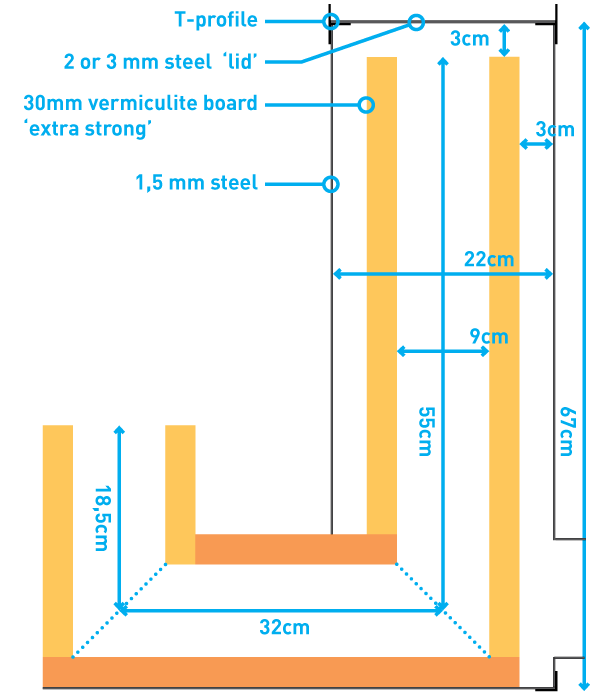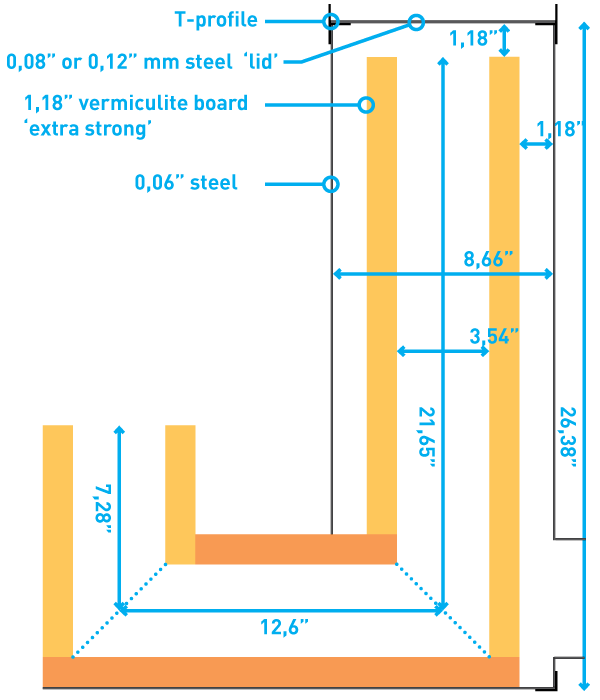So I organize cool group travels to remote places, usually a hut somewhere high in the mountains, and I built a portable sauna to enjoy during these trips. The sauna is 150x200cm and 140cm high. In the first days of the trip it fits four people; after some days it fits 6 to 8. I built a rocket stove for heating it. I am not a welder and, apart from a drill and an angle grinder, don't really have access to tools for processing metal, so for that rocket stove I used materials that could work for me without thinking all that much about the best result. I used two barrels; the outer some 60cm high and 40cm in diameter and the inner one 46cm high and 30 in diameter. The inner completely 'floating' with space also between the bottom of the two barrels. I had a 10x10cm J-tube welded out of 3mm strong steel and the space between the J-tube and the inner barrel filled with vermiculite. It kind of did what it had to do (and burned quite clean and efficient) but I wouldn't build it again like that. Especially the J-tube seems to be a way to big mass (both in kilos to carry up the mountain as in heat bank).
It's time for a better solution. My main prerequisites are:
- preferably no welding, bending etc
- as light/portable as possible
- should transfer most heat to the environment in the stove itself, before the chimney
- the thing gets fired up max. some 25 times per year for 3 to 4 hours.
Below a drawing of my new to-be-built rocket stove. I would highly appreciate any input/remarks/suggestions etc. about this design, before I start building it

The core of it is the feed/burn/riser tube built out of 3cm thick vermiculite board and a 'barrel' constructed out of steel plates that I would connect with L-profiles and simply bolt it together. The top plate would rest on T-profiles so that there is a bit of an 'edge' to contain the sauna rocks and a bit of water when I do an 'aufguss' (is there an English word for that?) The top plate would be of thicker steel than the rest (in my first rocket stove, the lid of the barrel did get red hot).
In my design the heat riser length is limited by two factors: I tried to make everything in a way that I would be able to make the whole thing using only one 100x60cm vermiculite board; and it has to fit in my car.
So I tried to respect the proportions between heat riser/burn tunnel/feeder length and the channel would measure 9x9 cm throughout the three. The square 'barrel' around it with 3cm distance on all sides; this makes that the CSA of the 'downwards' part is three times the CSA of the 'upwards' part. I am not so sure about the best distance between the top of the heat riser and the bottom of the steel 'lid'. I made it 3cm as well.
My initial doubts/questions are:
(1) does it make sense to build the system out of 3cm thick vermiculite board? Will it isolate enough? Will it need reinforcements (at the top for example) and if so, how?
(2) does it make any difference if the bottom of the burner sits on the bottom of the 'barrel', or should there be space between them?
(3) can I use the 12cm diameter chimney parts that I already have or should I attach a chimney with a smaller diameter?
(4) I read a lot about burn tubes that are to long - but can it be to short also? For portability, I would like to make it shorter. Would that be a bad idea?
For sure the 'veterans' on this subject will spot other flaws in my design and I am happy to get informed!
Thank you everybody!

 1
1












 1
1













 1
1



































